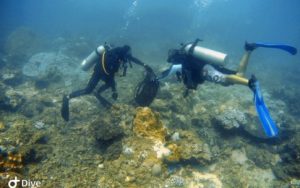By Perla Lena/Philippine News Agency

ILOILO CITY — The regional director of the Bureau of Fisheries and Aquatic Resources (BFAR) in Western Visayas on Friday appealed to scuba divers to address the crown of thorns starfish infestation in Antique’s Culasi town, particularly in Maniguin Island.
In an interview, Director Remia Aparri said her office conducted reef assessment and collection of the crown of thorns (COTs) last June 25 to 29, upon the request of the Culasi municipality.
“There is a state of calamity that was declared in Culasi in relation to the crown of thorns,” she said.
“They (COTs) are very dangerous because they prey on corals. When in large numbers, they cause a significant ecological disturbance in the coral reef system. When there are no more corals, there will no longer be a habitat for our fish,” she said.
The technical team composed of divers who conducted the assessment recommended the “immediate removal of remaining COTs to prevent further damage to the coral reef”, Aparri said.
The team, led by Aquaculturist II Mateo C. Doyola Jr., also recommended to “check and asses the corals reef, know the extent of population outbreak and have a mitigation action”.
Aparri said the crown of thorns is a starfish characterized by numerous spines projecting from its body wall. It has a large central disk and has around seven to 23 arms.
She said based on pieces of literature, the natural density is one COT per hectare or six to 20 individuals in a coral reef.
“There is an outbreak when there are more than 15 COTs per hectare. There is already an outbreak that’s why there is a state of calamity,” she said.
During the second day of the assessment, the technical team was able to gather 426 COTs on their target dive site. But a large number of COTs still needs to be extracted.
Dr. Jon Altamirano from the Southeast Asian Fisheries Development Center/Aquaculture Department (SEAFDEC/AQD) based in Tigbauan, Iloilo said the COT “naturally exists in coral reefs and their presence alone cannot be considered as an outbreak”.
Experts estimate that a COT can eat away about 10 square meters of corals per year. However, when there is an outbreak, COTs do not just eat “some” corals but they eat “a lot”.
“And they eat so fast that the corals cannot even recover. So, a massive outbreak can cause a major impact on the coral reefs,” he said.
Altamirano suspected the sudden increase in their population can be due to the “probable abundance of food, not for the adults (COTS), but for the planktonic larvae even before they settled in Culasi”.
“When larvae become well-developed, they need appropriate conditions before they settle on corals as ‘babies’ and grow to adults. Appropriate conditions for settlement mainly involve a proper substrate with good food. For COT, this means areas with good corals, which are their primary food. So, Culasi area may have been the best place for the planktonic larvae to settle where corals are abundant and healthy,” he said.
Aparri said due to overfishing, predators that prey on COTs are gone or their number has decreased.
The case in Culasi was the first COT outbreak that was recorded in Western Visayas but Aparri said there was also a presence of COT in Barangay Guisi in Nueva Valencia in Guimaras.
Altamirano recommended that when there are too many of them in the area, they should be culled, the most practical way is to be manually removal by divers, done with utmost care.
“The safety of divers is most important. COT thorns can cause severe pain and swelling when stung, so some implements may be needed. The integrity of the corals needs to also be maintained, so care on not destroying corals in the process must be observed,” he said.
He said there has to be “proper management on land because land-based activities cause a great deal of effect to the seas”.
Christopher Salao, a member of the Base Camp Diver, an association of some 20 to 25 members from Iloilo said that proper care must be undertaken when collecting the COTs because they are very sensitive.
Done wrongly, then COTs will get agitated, which will prompt them to release 100 to 1,000 eggs that will mature in two to three years.
Aparri appealed for more technical experts and scuba divers to join in the collection of COT in Culasi.
She said a group of divers was supposed to conduct another cleanup on July 16 but was postponed due to bad weather.
“This is one of our major interventions because one of our mandates is to conserve, manage and protect critical habitat,” she said.
For the latest updates about this story, visit the Philippine News Agency website.
